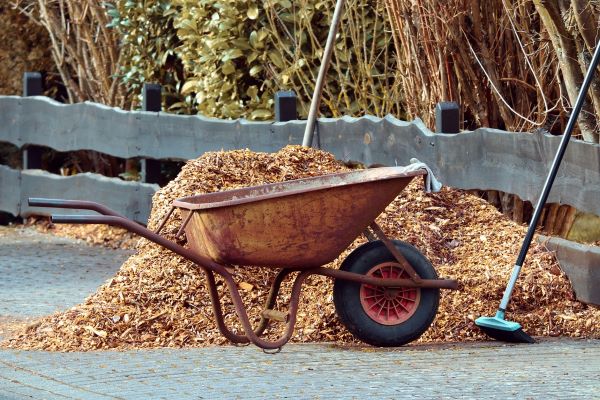Mulch in the Landscape

Mulch is very important to the overall health of our plants, but are all mulches created equal? Some may have more benefits than others and some may not be as helpful as we think they are.
Benefits of Mulch
Mulch, when properly applied, can provide a lot of great benefits to our plants, including:
- Moisture retention - Moisture loss is reduced with the cover of mulch and as mulch breaks down it increases organic matter in the soil which increases the water-holding capacity of some soils.
- Improved soil structure - Nutrients and organic matter are released into the soil as the mulch breaks down leading to better soil nutrients and reduced soil compaction.
- Weed control - Weed seed germination is slowed by mulch reducing the availability of light to the soil surface.
- Reduced weed trimmer or lawn mower blight - Adding mulch around plants creates space between tree trunks and shrub stems and the grass or weeds around them. If grass and weeds grow up around a tree or shrub, people are inclined to mow them down, often at the expense of the tree or shrub. Equipment injury from mowers and string trimmers, hitting and injuring tree or shrub bark, is very common and can be quite damaging.
- Moderates soil temperature - Mulch helps to keep the roots cool in the summer and maintains uniform cold soil temperature in the winter. Freezing and thawing of the soil can be harmful to plants. Organic mulch also doesn’t reflect heat back on to the plant like inorganic mulches do in some situations.
Organic Mulch Options
Wood chips are the most common form of mulch around trees. Most any type of wood chip mulch will work, but it is advised to use coarse chips versus fine mulches. The smaller shredded types of mulch are not best because they can mat together to form a barrier which doesn’t allow moisture to enter the soil through the mulch and it can also cause anaerobic conditions for the roots underneath the mulch.
Organic mulches will provide all of the benefits listed above. However, organic mulches do break down, which improves the soil, but need to be replenished periodically to maintain an effective layer. They are easier to work with and move around, than rock mulches, but can fly around in windy locations. Landscape edging may help to keep mulch in place when mowing around the edge of landscaped areas.
Inorganic Mulch
Inorganic mulches would include things like crushed rubber, river rock, and lava rock. These mulches will not provide many of the benefits listed above because they don’t break down to improve the soil, are very hot in the summer, and can reflect a lot of heat back onto the plant.
Inorganic mulches will not move as easily as the organic options, but are more work to put into your landscape at first. These do have a large initial pricetag, compared to organic mulches, but it would be a one-time payment rather than having to reapply annually.
Mulch and Termites
Many people believe that they shouldn’t use wood chip mulches around their house for fear of attracting termites to their home. This is not true, according to Linda Chalker-Scott Associate Professor and Extension Specialist from Washington State University, termites are not attracted to wood-based mulches, they prefer higher nutrient woody materials like cardboard. You can use the wood chip mulch up to the house’s foundation. If termites were in the tree when it was chipped to make mulch the termites would have died through the process and will not be introduced into your garden from the mulch. However, if you have an established termite population in the ground surrounding your garden, wood chip mulch can be a bridge from the soil to the structure. If you are concerned with termites around your garden, it would be best to consult a professional to set up monitoring or barrier control methods around your home.
What Not to do when Mulching
There is a limit on mulching. In some areas you may see very deep layers of mulch or what we refer to as the mulch volcano, where mulch is piled around trees to look like a volcano, but this is not advised. Mulch should be kept at 3-4 inch maximum depth. It should always be spread out to a uniform depth around the tree, flat like a pancake.
Mulching too deeply leads to shallow rooting, roots can develop in the deep mulch layers, and it can disrupt the flow of water to the soil. Mulch should be placed at least a few feet around the tree, if you can go out further that is better for the tree. Mulching to the dripline is the preferred width for mulch, but isn’t always feasible.
Finally, it is not advised to use weed barriers or fabric mats underneath organic mulch. These can disrupt the flow of water to plant roots and weeds can germinate through them or on top of them, so it doesn’t work well for what it is sold to do. Also, if you have ever tried to make changes to a landscape with landscape fabric, you understand how difficult that is once the fabric is in place. It breaks down and then pulls out in small strips and makes your landscape changes much more difficult than if it was not there in the first place.
Bottom line is organic mulch is very good for plants and provides many benefits, including keeping some “personal space” between your trees and mower. Use an organic mulch around your plants to help them live healthier, longer.
This article was reviewed by Sarah Browning & Kait Chapman
Sign up for updates from UNL Water
